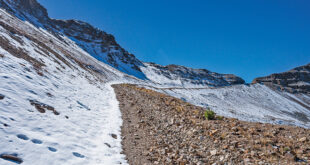Shoveling driveway snow Monday morning, I scraped up what looked like desert sand that had blown in on the super-strong Sunday winds. That dust tends to originate from the St. George, Utah area and settles on the white snow of our mountain peaks in such windy storms. It contributes to early snow melting when it absorbs the strong spring sun and has helped confuse climate patterns.
The strong winds and resulting dust impact our valley in a lot of ways. Scarp Ridge had 100 mile per hour winds Sunday. There was even a recording of 94 miles per hour in Mt. Crested Butte. The wind kept most of us awake early Monday morning. Diane and I quickly moved the grill from the deck to the living room about 3 a.m. as a precaution against it being blown into the neighborhood.
Monday’s skiing was marginal, as the snow was scraped by wind gusts all day. Heavy winds contribute to heavy avalanche danger. Spring dust screws with the spring runoff and hurts the fun backcountry corn skiing. In other words, shifting dust from Utah to Crested Butte is not all that good for us.
Chamber’s Gothic shift is baffling
I am still scratching my head over the Crested Butte-Mt. Crested Butte Chamber of Commerce decision to shift focus and pull out of what appeared to be a really good deal with the Rocky Mountain Biological Laboratory. For three years the chamber had a major presence in Gothic to engage tourists—especially tourists near the local backcountry. For a mere $3,000 they were able to talk to a lot of visitors. In fact it appears that about 40 percent of their in-person summer visitor contacts took place in Gothic. To pull out of that position seems shortsighted if not plain silly. Add to the situation the fact that the town will be building a new transit center at the Four-way Stop this summer, which will likely scare off some motorizing tourists from pulling into the construction zone that will be the main Visitors Center.
Eliminating a proven tourism contact location just doesn’t make a lot of common sense—especially for the chamber, which in my mind has a key role in contacting, educating and guiding tourists once they arrive in the valley. It is easy for the community in general to keep talking the talk about the need for collaborative partnerships that mitigate the impacts of tourism, but this smacks of walking away from the talk. As Gothic has obviously gotten busier in the summers and nearby ranches, federal lands and public roads have felt the impacts, the decision to chop off a chance to educate backcountry visitors about an obvious growing problem is disappointing and should perhaps be reconsidered by the chamber board that made the decision.
Crested Butte’s STR shift is positive
compromise
The Crested Butte Town Council shifted yet again on the short-term rental issue. But they seem to have moved toward a reasonable conclusion and compromise. Using a cap-and-zone equation—a combo of zoning that is already in place and a percentage cap admittedly grabbed out of thin air—the council is trying to contain STRs and the big picture impacts to the community while allowing vacation rental properties in town. It hasn’t been easy and I’m not sure their latest direction is the answer. But I don’t think there is a clear answer so they are at least keeping some neighborhoods STR-free. I believe in the long run those will be the most desirable neighborhoods in town so I don’t see any negative economic impact by keeping some neighborhoods free of STRs.
During the Monday discussion the council was going under the assumption that about 28 percent of the houses in the zones that allow STRs currently have licenses. And while I am not great at math, my calculation that 206 houses out of a potential 646 free market units in the permitted zones have STR licenses calculates closer to 32 percent. That may or may not have made a difference when they chose the 35 percent cap but I must say that it’s easier to make good decisions with solid information and solid information has shifted many times throughout this STR discussion process. Anyway, under this new proposal, about 20 more dwellings would be allowed to get their STR licenses to reach the 35 percent limit. That in essence would cap the STR total to 226 houses plus the current “grandfathered-in” 58 dwellings in prohibited zones. There are now 923 free-market homes in Crested Butte so the maximum percent of STRs in town would be about 30 percent, not including deed-restricted residences.
Now of course there were only five citizens at the council discussion on Monday and that was a lot less than normal so the council could change direction again if they get more of a crowd at the next two meetings where they will consider the actual ordinance. We’ll see…
Mt. CB Performing Arts Center funding shifts heavily to public dollars
It seems every time I look at the Mt. Crested Butte Performing Arts Center proposal, aka the Biery-Witt Center, I wonder why it’s not called the Mt. Crested Butte Downtown Development Authority Performing Arts Center in Mt. Crested Butte. Okay, that’s not a catchy name but the DDA and town of Mt. Crested Butte are putting in millions and millions of public dollars to the project that originally was going to be funded with a lot of private donations. Currently the public entities have committed about $7.8 million. And what started out as a $6 million bond issue contribution could possibly creep up to perhaps as much as $19 million (over the life of the loan) if the DDA gets another 20-year extension. Wow…
And who do you think will ultimately be responsible for operating costs if projections (which are always extremely optimistic) don’t pan out?
The town or the non-profit that is applying for the loan? I think we all know the answer.
While having that conference/arts center will no doubt bring more people to the village and add a nice centerpiece for the town, the shifting reliance on public funding should be noted especially as the cost of the project continues to climb.
Where are the weed sales shifting?
Crested Butte sales tax figures indicate there has been a shift in weed commerce. This past January compared to January 2016 showed a reduction of more than 40 percent in legal Crested Butte marijuana sales. It isn’t hard to guess that one reason might be the proliferation of weed dispensaries in Gunnison. Down-valley consumers are shifting their buying habits south. The town still took in $7,000 in marijuana sales tax revenue but the wind seems to have shifted the sweet smell of diesel down-valley.
Shift your clock Sunday
Oh, and finally, the most immediate shift will come at 2 a.m. this Sunday morning. That’s when you have to move your clocks an hour ahead. Spring forward under the full moon with Daylight Savings Time…
Anyway, the sands of life at 9,000 feet continuously move and shift, and where the grains land makes a difference. While we can’t stop the wind, we can guide where some of that dust lands…if we pay attention and choose to do so.
—Mark Reaman
 The Crested Butte News Serving the Gunnison Valley since 1999
The Crested Butte News Serving the Gunnison Valley since 1999





